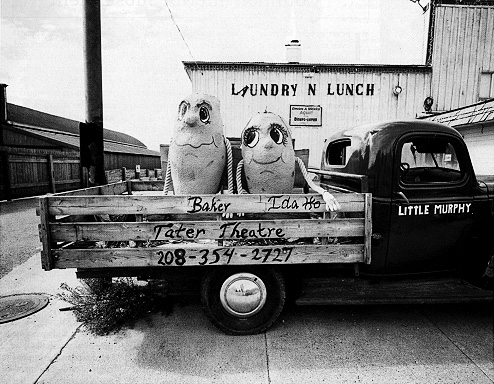American idols: in Driggs, Idaho, September 30, 2000, photographer Kennerly encountered a pair of promotion-minded taters.

[click image to enlarge] © 2002 The Smithsonian.
by Victoria Dawson
Rushing from news story to news story, Pulitzer Prize-winning photojournalist David Hume Kennerly used to agonize over the pictures he missed—particularly the unexpected shots that had nothing to do with the assignment at hand.
So in December 1999, he came up with what he calls a “whimsical notion.... This time I wouldn’t speed across that covered bridge to get to the big event on the other side, but instead I would slow down a bit, maybe even pause to take a picture of the bridge.” While on assignment for Newsweek (in 38 states and seven countries, as it turned out), he brought along another camera, a Mamiya 7, designated for taking a least one picture, every day for a year, just for himself.
|
American idols: in Driggs, Idaho, September 30, 2000, photographer Kennerly encountered a pair of promotion-minded taters.
|
The result: Kennerly’s fourth book, Photo du Jour: A Picture-a-Day Journey through the First Year of the New Millennium (University of Texas Press). Selected images from that project, 150 in all, appear in a traveling exhibition of the same name, which opened in October at the Smithsonian’s Arts and Industries Building in Washington, D.C. (The show moves on to cities that include Los Angeles, California, Portland, Oregon, and Austin, Texas.)
There were days when Kennerly, best known as Gerald Ford’s official White House photographer when he was president, was stuck in an airport or on a plane or bedridden after knee surgery. No matter, a picture had to be taken. Of his sons, Nick, Jack and Byron. Of a fern in his Santa Monica backyard. Of a mausoleum at the Hollywood Forever Cemetery, or of the Love of Christ Detail Shop in Macon, Georgia, or of John McCain on “The Straight Talk Express.”
A single quirky image, of two gargantuan, concrete potatoes in the back of a pickup truck, symbolizes what Kennerly went looking for. He took it in Driggs, Idaho.
“This is the first time we’ve had publicity on my little truck,” says Richard Wood, referring to the 1946 Chevy that ferries around the oversize spuds. Once used to promote Wood’s now defunct Tater Theatre, a downtown Driggs movie house, the ersatz potatoes now draw the curious to Wood’s remaining cinematic enterprise, the Spud Drive-In, two miles south of town.
“There is a constant stream of traffic,” Wood reports. “Folks like to climb right into the truck, stand beside the potatoes. I’ve seen as many as six people getting into the bed of the truck to have their picture taken.”
Kennerly understands. “My dad was a salesman, an entrepreneur, a bit of a showman,” Kennerly says. “A couple of giant potatoes in a truck advertising a theater—it’s a corny, charming, funny thing to do. Something he would have done. I can hear him saying ‘I’ve got a great idea!’”
from The Smithsonian, December 2002 v. 33, no 9, pp 39–40.